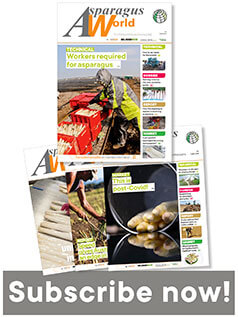Growing “European” white asparagus with a Tasmanian flavour
Is there any interest in fresh white asparagus in Australia? In November, Tasmanian white asparagus grower Richard Weston was interviewed for a public radio program aired in German in Australia and says within 24 hours his company had 7,000 more followers on Facebook and 600 direct contacts from people in Australia wanting to buy its white gold. That response suggests there is indeed a lot of unmet demand in cities such as Sydney, Melbourne, Adelaide and Brisbane, “so we’re working on how to fill that market gap,” he told Asparagus World in March this year. “The demand is there – we’ve just got to produce the goods now.”
Fever for edible ivory sets in
The impetus for Weston’s interest in the delicacy was a conversation in 2012 with renowned local chef Luke Burgess, who had just come back from working in Copenhagen’s famed Noma restaurant and raved about the amazing white asparagus they had used. His curiosity sparked, Weston, already a supplier of vegetables to top restaurants in Tasmania, started his research and in 2013 went to Europe on a Nuffield Farming Scholarship to spend three months studying white asparagus production in the Netherlands (spending time with experts from Bayer and Teboza) and Germany and Spain. It was there that he tasted white asparagus for the first time and wondered why something so popular and so tasty remained little-known in Australia, sowing the seeds of a dream to one day grow premium fresh European varieties himself in his home state of Tasmania.
Early attempts fail due to heavy soil
Back in Australia, in about 2014, Weston and wife Belinda made a first attempt to grow white asparagus, with one hectare planted on a friend’s cherry farm in southern Tasmania. They planted about 35,000 asparagus plants grown from seeds imported from Europe. (Australia’s biosecurity rules prevented the import of crowns, Richard Weston said.) The plants grew beautifully in the Tasmanian climate but the heavy soil was not quite right, being high in magnesium and becoming very hard when wet, making harvesting difficult. “It took three years just to get that first crop and it had to be ploughed back in,” he said.
Sandy loam with good drainage found

The Westons then partnered with fellow farmers Tom Barham and Jenna Howlett, whose property in Brighton, just 100 m from their own farm and 35 km north of Tasmanian capital Hobart, has fertile sandy loam with good drainage – similar to what Weston had seen growing white asparagus in Europe – as well as a perfect microclimate. Thus, in 2018 they started afresh, planting 34,000 plants on 1.4 ha, and launching ‘Tasmanian White Asparagus’, dedicated to growing premium European varieties of white asparagus. “It was very hard work,” Richard remembers.
First commercial harvest in 2022
They let the plants grow for four years then started their first commercial harvest on September 1, 2022, continuing for about four weeks – the company was being careful not to over-harvest – and obtaining 2.5 tons of white asparagus in what was an “incredibly wet” year. In contrast, winter of 2023 was “incredibly dry” in Tasmania and spring temperatures were “exceptionally warm,” thus making drip irrigation necessary. The warmer soil temperatures led to some blushing of the asparagus tips, “which doesn’t affect the amazing taste of white asparagus, it’s just a crowning of the king of spring,” Weston said. Three back-to-back overnight frosts kept the harvest rhythm slow at the start of the 2023 season but momentum eventually picked up and this second commercial harvest – which ran for about eight weeks, from August 31 to about October 26 – provided 7 tons. “And hopefully this year we’ll go higher again,” he said. “But it won’t be till we have five years of data that we will see how our quantities will be.” As the crop matures, the firm hopes its yield will reach around 10 tons/ha, using as a reference top growers in Europe who average yields of 6-14 tons/ha.
About 70% of crop is AAA grade

For last year’s harvest, about 12 people, mainly backpackers (3 Nepalis, 2 Italians and 7 Brazilians), were employed for field work and another six in the packing shed, with similar numbers anticipated this year. The farm hands are recruited through labour hire companies and are due a minimum hourly wage (pre-tax) of AU$27.45 (~€16.55). Harvesting starts about 7am: “We bend down and gently dig to expose each spear so we can clearly see where to cut and, using a special curved harvesting tool, cautiously make a snick to remove each spear, one by one and row by row,” Weston says. The spears are picked into crates which, when full, are taken to a cool store on Weston’s farm where they are washed then placed in 2.5°C water overnight to cool them quickly. The next day they are taken out of the ice slurry and graded and sorted in a packing shed on the Westons’ farm, where they are generally stored until orders come in, which usually means dispatch to Hobart airport. The spears are graded into three categories: AAA premium grade (stem diameter of 20+ mm), AA (16-20 mm) and A (10-16 mm). Nearly 70% of the company’s commercial crop has been AAA grade. At time of speaking in mid-March of 2024, Weston said they were set to harvest a total of 54,000 plants across 2 ha this year (including about 20,000 plants of a new variety it is trying that were about to go in the ground) and envisaged a harvest of 14 tons, “but possibly as high as 18.”
Asparagus rust about the only disease issue
The company pretty much follows European planting practices, Weston says, with 18 cm spacings between plants, grown in mounded beds, and underground drippers 1.8 m apart. For the first year of commercial production, the plastic covers over the rows were black facing up but with the local climate warmer than Europe’s main growing regions, from the second year the company has used the white face up. Australia is lucky not to have a lot of the diseases or pests seen in Europe. The biggest issue has been asparagus rust, he said.
Trial and error, particularly in packaging
Packing and logistics are areas in which the company seeks to improve, particularly since many of its spears are destined for high end eateries and, in accord with their premium price, must arrive in perfect condition. To reach mainland Australia they are air freighted in 1 kg packs in 5 kg boxes and there was a lot of breakage in the first year, mainly upon loading and unloading as air cargo. Sturdier packaging is now being used and the airport cargo handlers will aim to limit how many boxes are stacked on each other. The company is still experimenting with the best material for its 1 kg packs, having tried options including paper, bubble wrap and vacuum packs, and is currently using biodegradable plastic vacuum seals.
Investigating ways to reuse waste products
When it comes to the spears themselves, “wastage is too high at the moment,” Weston said. Because the soils are quite cold in Tasmania in winter, the plants become quite brittle and require delicate handling. Because each year the harvest workers change, the new ones must be trained in how to avoid breakage. “We’re getting better every season at finding uses for the offcuts,” he said. With all the spears cut to a uniform length of 22cm, the trimmings are sold as soup-grade in 5 kg vacuum packs.
European white asparagus cultivars

The company will be using five different varieties in a bid to widen its supply window. It says it has gone to great lengths to choose genotypes that suit Tasmanian conditions and will deliver the desired flavour and spear shape while also growing to a good size. It prides itself on the varieties it has invested in and as a result, prefers not to reveal details of them except to add that they are premium European white asparagus cultivars. Weston says he was fortunate to be able to spend time in the Netherlands with some of the best growers in the world and learn about the great care they’ve taken to breed their special varieties. He will say, however, that the seeds are from Bayer and Bejo and he expects to get 10-14 years of production from them.
How Aussie chefs are using Tasmanian white asparagus

In September and October last year, Sydney’s celebrated Quay restaurant was pairing Tasmanian white asparagus with a Queensland mud crab custard; the Chophouse, also in Sydney, served it with pancetta and cured yolk; while in Victoria, Paringa Estate offered the delicacy with butter poached King Island lobster, bottarga and yellow tomato vinaigrette. These are just examples of high-end eateries around Australia eager to work with the new product, which is seen as very niche, Weston said. “It comes in at the end of winter before the spring vegetables kick off so it’s a really good window when chefs are chasing great products to fill that seasonal gap. The feedback we’ve had from some of Australia’s best chefs is that the quality is as good as they’ve tasted in Europe. They’ve been very happy and very supportive. We really are starting to kick some good goals here.” Top chefs in Japan have also been eyeing off the vegetable, as well as buyers in Hong Kong and Malaysia, but for now, Weston is focusing on filling local demand. “Our main job in Australia is to educate people to cook white asparagus as traditionally they’ve used green,” he said.
























